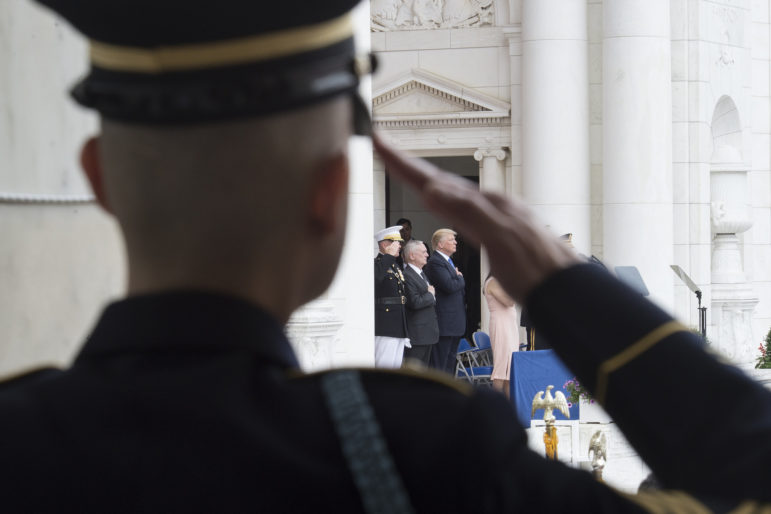
Adi Talwar
United Metro Energy's Greenpoint facility on the southern bank of Newtown Creek in Brooklyn. The company won a contract by the Defense Logistic Agency to supply various types of fuel worth $145,541,015.
Military contractor SRC claims that its “research and development in radars and electronic warfare systems helps to defend our warfighters and the security of our nation.” With its main headquarters in Syracuse and offices all across the United States, SRC has for decades provided the military with services. In the two years since Donald Trump took office, SRC and a subsidiary have been awarded a total of $391,182,750 in contracts and been named part of consortia awarded $45 billion more in defense work.
Military spending has increased vastly under President Trump. According to the Center for American Progress, Trump proposed a budget of $639 billion in 2018, $56 billion more than what was proposed for FY 2017. For the 2019 fiscal year, Trump increased funding again by $93 billion. In increasing defense spending overall, the funding for defense contract spending also went up.
SRC Inc. is an example of ways both large and small in which defense contractors in New York are benefitting from the changes made by the Trump administration. Although the company declined to comment, the company’s website announces its contract wins.
One recent contract, announced on November 1st, is a $33 million deal to enhance the nation’s electronic warfare integrated reprogramming database. The database is used to store data on enemy threats. SRC’s job over the next few years is to perform signal analysis, engineer assessments, perform research, and give support to the U.S. Army National Ground Intelligence Center. The release says the new contract and previous ones will allow the company to fill over 200 positions worldwide in diverse areas of engineering, field application support and program management over the next year.
“This Army contract is yet another shot in the arm for the Central New York economy and further indication that SRC’s workforce produces top quality products that the Department of Defense relies upon to succeed in some of the toughest missions around the globe,” U.S. Senate Minority Leader Charles E. Schumer, New York’s senior senator, said in the press release.
SRC is not the only one contributing to the New York economy through the recent contracts awarded by the DoD. According to Department of Defense awards postings, New York firms, in the less than 24 months since Trump took office, have been awarded over $11 billion in defense contracts—not counting billions more in shared contracts. After increasing in 2017, total defense contract obligations—which are different from contract awards—involving New York State firms dipped slightly through the first 11 months of 2018.
Some of those contracts are for old-fashioned supplies, not new military technology—like the contract by the Defense Logistic Agency to supply various types of fuel that was awarded to United Metro Energy of Brooklyn, worth $145 million.
In fiscal year 2016 the top five contractors in New York were Lockheed Martin, Northrop Grumman, Harris, Bechtel Group, Interpublic Group of Companies, BAE Systems. According to usaspending.gov, the top New York contractors that received prime DoD contracts from January 2017 to early December 2018 are Lockheed Martin, Harris Corporation, Metropolitan Life Insurance Company, SRCTEC LLC, and Northrop Grumman Systems Corporation.
“This is historic,” said Robert Levinson, the senior defense analyst at Bloomberg Government, who added that defense contract spending as a whole went up by about $24 billion dollars in Fiscal Year 2018. “Prior to this period, the highest period was really the end of the Bush administration, the beginning of the Obama administration, 2008, 2010.”
Not all of the amount being spent comes from contracts initiated by the current administration.
According to Andrew Hunter, one of the authors of a report on military contracting published by the Center for Strategic and International Studies, most of the money being spent by the Trump administration reflects decisions made by previous leaders. “In the early stages, they’ve done a lot to buy things that are already in production,” said Hunter, who once served as the chief of staff for acquisition, technology, and logistic in the Obama administration and also in the Joint Rapid Acquisition Cell in the Department of Defense.
The increase in defense spending is a combination of the administration fulfilling past obligations as well as increasing the production levels of previous contracts. However, the level of spending is only part of the story. Another side is the way the administration is using budget mechanisms like other transaction authority and prototype contracts in their acquisitions, and speeding up the contract process.
New ways of spending
“This is in tune with the Trump’s sort of overall anti-regulation attitude,” Levinson said, adding that the administration has bypassed some of the slow, bureaucratic processes that characterize defense contracting. “Everybody is kind of frustrated with the process. The Trump administration has been getting after it. They’re trying to streamline some of this stuff, getting rid of unnecessary rules.”
According to Levinson, the regular process of defense contracting is long and rule-bound, and involves the exchange of extensive paperwork between the government and the contractor. Levinson says that this administration has found a way to try to get around the rules through Other Transaction Authority (OTA).
Other Transaction Authority is a process that has been in place since 1957. It allows the military to skip normal contracting rules. Under OTA, the military allows contractors to form consortia. The Defense Department then asks contractors to submit what Levinson calls “white papers” or informal proposals for the job they are looking to fill. With the use of the OTA, two significant sets of federal regulations (Federal Acquisitions Regulations and Defense Federal Acquisitions Regulations) are waived and a significant amount of time is cut from the contract process.
Levinson said that compared with other administrations, the current administration has doubled the amount of money they spent using OTA. He says that in 2017, the DoD spent $2.1 billion compared to the $695 million spent in 2015—a small but growing part of the contracting pie.
The growth is on track to continue, he says: “I don’t even have a complete data set for fiscal 2018 because the DOD delays the data for 2018, I already have $2.6 billion using other transaction authority and, and I’m not even complete.”
Hunter says there are pros and cons to using OTA. He says that the use of OTA gives the DoD the chance to “negotiate everything in a completely tailored fashion” without the required contract language.
“One of the concerns is whether the increase is [pursuing innovation] or a way to do normal government contracts with fewer rules, ” said Hunter. He says he sees a little bit of both. “It’s really good if you’re trying to do something innovative or working with small contractor,”
An identified small contractor is Rand Machine, previously known as Premiere Precision Machining. Located in Falconer, N.Y., Rand Machine is a “custom / build-to-print manufacturing company,” according to its website. The company, which has been around for 68 years, specializes in prototype and production machining. In the past, Rand was a subcontractor, meaning that big contractors like SRC hired the company to perform defense jobs. This August, Rand was awarded a contract to compete with two other companies for the order of $29,900,000 to obtain two different types of suspension lug. A suspension lug is a weapon that attaches weapons to airplanes and aircrafts.
According to Rand’s Technical Sales and Program Manager, Jason Ruhlman, things have been moving at a faster pace with the Trump administration than they were with the Obama administration. “Government contracting is a slow process,” Ruhlman said. “Right now, with the defense spending, it appears that not a lot of waiting is going on.”
Ruhlman said that he has also noticed that the large amounts of spending available for defense means more opportunities for companies like his.
“I think right now this administration is really making the conservative effort,” Ruhlman said, referring to the right’s traditional, expansive view of military spending.”There are just many opportunities and there’s funding out there for it. More people have gotten more auction notices. I believe right now this administration is valuing what we do.”

Official White House Photo by D. Myles Cullen
The president has increased spending on projects identified before he took office. His Defense Department has also taken steps to bypass procedures that slow the contracting process down.
Testing new ideas
Other than spending more and working around contracting rules, Trump’s administration is also breaking the mold in what and how they are buying when it comes to defense contracts.
“They seem to have embraced prototyping as their main approach to acquisition,” Hunter said, adding that it is an “effort to speed up the process.”
According to the U.S. Government Accountability Office’s 2017 study on weapon systems, the DoD invests about $70 billion every year in “weapon system research, development, test, and evaluation, including prototyping activities.” The accountability office defines prototyping as “the development and testing of a model or system design that uses available or emerging technologies.” While regular contracting can take 20 years or more, prototyping takes less time. It lets the DoD know much sooner whether a technology would work. Hunter adds that it gives the government an out in case they do not like the result of the prototype, they do not have to commit to buying the product.
“In areas where tech is moving quickly, there’s an advantage to the prototype approach,” Hunter said. “In areas where you kind of know what you’re going to do, if you know what you want, go buy it.”
In New York, at least three companies were granted prototype defense contracts last year.
On September 27, 2018, Saab Defense and Security USA LLC in East Syracuse was awarded $8,184, 781 for the research and development of an X-Band Active Aperture Array radar prototype in support of the Office of Naval Research and the Office of the Secretary of Defense Foreign Comparative Testing Program for the Navy.
Get the best of City Limits news in your inbox.
Select any of our free weekly newsletters and stay informed on the latest policy-focused, independent news.
Saab is a company with about 300 employees and over $135 million in U.S. sales. The company develops technology both in the United States and Sweden. It’s identified by the DoD as a foreign owned company incorporated in the U.S. Contacted for comment about the award, the company says that it is not in a position to add more than was in the Justifications and Approval notice published by the Department of the Navy.
“This order is yet another proof of Saab’s state of the art gallium nitride based AESA radar development and further strengthens our offer of advanced radars and sensors”, says Anders Carp, head of Saab’s business area Surveillance in a statement released on October 26,
Dayton T. Brown Inc., located in Suffolk County’s Bohemia was awarded a shared contract with eight other companies. The maximum amount for the contract is $486,952,035 between all companies. The contract is for a prototype that modifies air vehicles, mission systems, and other naval systems. It was awarded on September 6, 2017.
Northeast Information Discovery Inc was awarded $17,826,958 in March, 2017 to “research, develop, integrate, prototype, demonstrate, validate, and verify new software capabilities for a software-defined and reprogrammable transceiver that has broad applicability to military-relevant missions.” Northeast is considered a small company by the Department of Defense. It is a woman-owned business with headquarters in Canastota.
“A lot of what they’re doing is laying the foundation of what will happen in the years to come,” Hunter said. He adds that what the administration is acquiring is competing with the great powers such as Russia and China. “It’s just an evolution of military need.”








